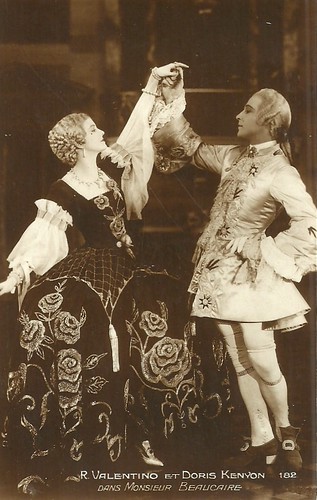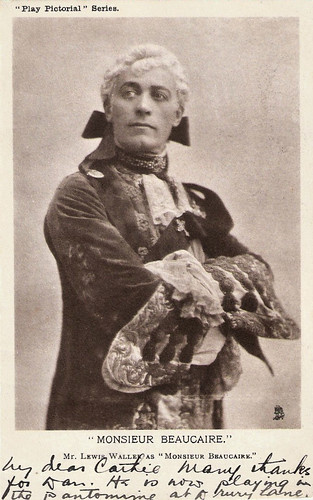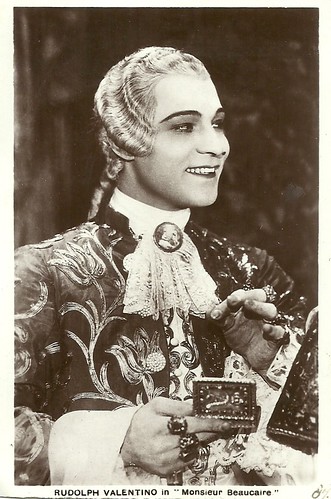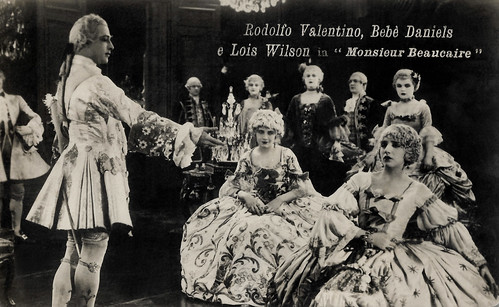
French postcard by Cinémagazine-Édition, no. 23. Paramount. Photo: Rudolph Valentino and Doris Kenyon in Monsieur Beaucaire (Sidney Olcott, 1924).

French postcard by Cinémagazine-Édition, no. 164. Photo: Rudolph Valentino in Monsieur Beaucaire (Sidney Olcott, 1924).

French postcard by Cinémagazine-Édition, no. 182. Rudolph Valentino and Doris Kenyon in Monsieur Beaucaire (Sidney Olcott, 1924).

Dutch postcard by J.[Jos] M.H. Nuss, Laren, no. 1. Rudolph Valentino in Monsieur Beaucaire (Sidney Olcott 1924). Picture: Frank Godefroy. Paramount.
Humiliated and insulted he flees to England
'Monsieur Beaucaire' is a short novel by Pulitzer Prize-winning author Booth Tarkington that was first published in 1900. The story has been adapted several times. In collaboration with Evelyn Greenleaf Sutherland, Tarkington adapted it as a play in 1904 starring Evelyn Millard and Lewis Waller.
The play received a Royal Command Performance at Windsor Castle before Edward VII. André Messager used it as the basis for an opera of the same name in 1919. Tarkington was credited as co-author of the screenplay of the 1924 film adaptation which starred Rudolph Valentino.
The Duke of Chartres (Rudolph Valentino), a favourite at the court of France's King Louis XV (Lowell Sherman), has fallen in love with Princess Henriette (Bebe Daniels), who, to his greatest regret, does not seem interested in him. Rather, she continually humiliates and insults him out of jealousy, whereupon he flees to England, banished by the king. But Louis XV insists that the two marry each other. As a result, His Highness leaves his high noble existence and becomes a bourgeois.
As Monsieur Beaucaire, he advances to become the barber of the French ambassador in London and begins to enjoy life beyond aristocratic obligations. After catching the British Duke of Winterset (Ian McLaren) cheating at cards, he forces Winterset in sneaking Beaucaire into a great ball, disguised as the Duke de Chartres, and to introduce him to the beautiful Lady Mary (Doris Kenyon), whom he adores.
Winterset complies with this blackmail but secretly seeks revenge in order to expose the suspected barber to ridicule. He makes Lady Mary believe that the supposed nobleman introduced to her has to eke out a living as a barber. As a result, the smug British woman abruptly loses interest in the French beau.
Eventually, however, she learns that the barber she has spurned is in fact the Duke of Chartres and now tries to win him back with the weapons of a woman. But the Duke of Chartres returns to France, where Princess Henriette, who had secretly pursued his return to the French court, finally begins to reciprocate his affection.

British postcard. Photo: Lewis Waller in the tile role of the stage play 'Monsieur Beaucaire'.

British postcard by Raphael Tuck & Sons in the Play Pictorial Series, nr. 5A. Photo: Lewis Waller as Monsieur Beaucaire in the stage play 'Monsieur Beaucaire'.

British postcard. Rudolph Valentino in Monsieur Beaucaire (Sidney Olcott 1924).

British postcard in the Picturegoer Series, London, no. 193. Rudolph Valentino in Monsieur Beaucaire (Sidney Olcott, 1924).
Part of a series of box office and critical disappointments
Monsieur Beaucaire (Sidney Olcott, 1924) was produced by Famous Players-Lasky and distributed by Paramount Pictures. It was filmed at Kaufman Astoria Studios in New York City.
The action is set at the court of King Louis XV of France. Therefore Olcott chose the atmosphere to be resolutely French and French-speaking. It is French dancer Paulette Duval's second American picture. The Belgian André Daven, who plays the brother of Valentino's character, was hired for his resemblance to the Latin lover. The Nantes-based Georges Barbier designed the 350 costumes. The film's dialogues were written in French for more realism. Valentino speaks French, as do Bebe Daniels, Lowell Sherman and Sidney Olcott.
Monsieur Beaucaire was part of a series of box office and critical disappointments that plagued Valentino's mid-career. Although the film did fairly well in big cities, it flopped in smaller locales, and could not exceed the expensive budget Olcott put into the film's production. Historians Kevin Brownlow and John Kobal suggested that the film's shortcomings stemmed more from Olcott's "pedestrian" direction.
Many viewers and critics, perhaps expecting the more virile Valentino of his earlier films, felt that his onscreen persona with its heavy makeup, frilled attire, and arch mannerisms (particularly in the first half) was overly feminised in Monsieur Beaucaire: a somewhat unfair accusation, considering that much of the film satirises the excesses of the court of Louis XV.
Much of the blame for the film's alleged shortcomings was assigned to Valentino's wife Natacha Rambova who was felt by many of Valentino's colleagues to have had an undue influence on the costumes, set and direction of the film. Alicia Annas wrote that audiences were most likely alienated by the general design of the film which, while historically accurate, was not tailored to 1920s American filmgoers' tastes. The Stan Laurel parody Monsieur Don't Care (Scott Pembroke, Joe Rock, 1924) reflected the general public attitude toward Monsieur Beaucaire.
The novel 'Monsieur Beaucaire' was later adapted into a musical film, Monte Carlo (1930), directed by Ernst Lubitsch. The story was filmed again as a comedy, Monsieur Beaucaire (George Marshall, 1946) starring Bob Hope and Joan Caulfield. The biopic Valentino (Lewis Allen, 1951) with Anthony Dexter, includes a sequence dedicated to Monsieur Beaucaire. A long sequence dedicated to Monsieur Beaucaire also appears in the film Valentino (Ken Russell, 1977), with Rudolf Nureyev in the title role and John Justin in the role of Sidney Olcott.

Austrian postcard by Iris Verlag, no. 372/1. Photo: Paramount-Film. Photo: Rudolph Valentino in Monsieur Beaucaire (Sidney Olcott, 1924).

Austrian postcard by Iris Verlag, no. 372/4. Photo: Paramount-Film. Rudolph Valentino and Doris Kenyon in Monsieur Beaucaire (Sidney Olcott, 1924).

Italian postcard by Ed. Ballerini & Fratini, Florence, no. 64. Photo: SAI Films Paramount, Roma. Rudolph Valentino in Monsieur Beaucaire (Sidney Olcott, 1924).

Italian postcard by Ed. Ballerini & Fratini, Firenze. Photo: Rudolph Valentino, Lois Wilson and Bebe Daniels in Monsieur Beaucaire (Sidney Olcott, 1924).
Sources: Wikipedia (English and German), and IMDb.
No comments:
Post a Comment